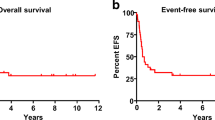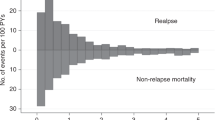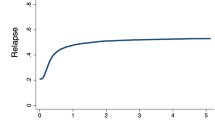Abstract
Outcomes in patients with acute lymphoblastic leukemia (ALL) who experience relapse after allogeneic hematopoietic cell transplantation (HCT) are unsatisfactory. This study aimed to evaluate the outcomes of patients with ALL who underwent second HCT (HCT2) for relapse after first HCT. It was a single-center retrospective study including adult patients with ALL who underwent HCT2 between 1991 and 2020. The cohort was stratified according to the transplant year, and included 39 patients with a median age of 29 years. A more recent transplant year was associated with achievement of complete remission (CR) and use of reduced-intensity conditioning (RIC), compared with an earlier transplant year. The overall survival (OS) rate and 2-year cumulative incidence of non-relapse mortality (recent vs. earlier) were 55% vs. 8% (P < 0.001) and 26% vs. 75% (P < 0.001), respectively. In multivariate analysis, non-CR (vs. CR; HR 3.6, 95% CI 1.2–11.3, P = 0.025) and myeloablative conditioning (vs. RIC; HR 3.5, 95% CI 1.3–9.4, P = 0.011) were negative prognostic factors for OS. Outcomes of the recent cohort from real-world data are promising, and achieving CR and using the RIC regimen at HCT2 may be an important therapeutic strategy.
Access this article
We’re sorry, something doesn't seem to be working properly.
Please try refreshing the page. If that doesn't work, please contact support so we can address the problem.

Similar content being viewed by others
References
Fielding AK, Richards SM, Chopra R, Lazarus HM, Litzow MR, Buck G, et al. Outcome of 609 adults after relapse of acute lymphoblastic leukemia (ALL); an MRC UKALL12/ECOG 2993 study. Blood. 2007;109(3):944–50.
Gökbuget N, Stanze D, Beck J, Diedrich H, Horst HA, Hüttmann A, et al. Outcome of relapsed adult lymphoblastic leukemia depends on response to salvage chemotherapy, prognostic factors, and performance of stem cell transplantation. Blood. 2012;120(10):2032–41.
Kako S, Kanamori H, Kobayashi N, Shigematsu A, Nannya Y, Nakamae M, et al. Outcome after first relapse in adult patients with Philadelphia chromosome-negative acute lymphoblastic leukaemia. Br J Haematol. 2013;161(1):95–103.
Spyridonidis A, Labopin M, Schmid C, Volin L, Yakoub-Agha I, Stadler M, et al. Outcomes and prognostic factors of adults with acute lymphoblastic leukemia who relapse after allogeneic hematopoietic cell transplantation. An analysis on behalf of the Acute Leukemia Working Party of EBMT. Leukemia. 2012;26(6):1211–7.
Kantarjian H, DeAngelo D, Stelljes M, Martinelli G, Liedtke M, Stock W, et al. Inotuzumab ozogamicin versus standard therapy for acute lymphoblastic leukemia. N Engl J Med. 2016;375(8):740–53.
Kantarjian H, Stein A, Gokbuget N, Fielding AK, Schuh AC, Ribera JM, et al. Blinatumomab versus chemotherapy for advanced acute lymphoblastic leukemia. N Engl J Med. 2017;376(9):836–47.
Maude SL, Laetsch TW, Buechner J, Rives S, Boyer M, Bittencourt H, et al. Tisagenlecleucel in children and young adults with B-cell lymphoblastic leukemia. N Engl J Med. 2018;378:439–48.
Cortes JE, Kim DW, Pinilla-Ibarz J, le Coutre P, Paquette R, Chuah C, et al. A phase 2 trial of ponatinib in Philadelphia chromosome-positive leukemias. N Engl J Med. 2013;369:1783–96.
Kishi K, Takahashi S, Gondo H, Shiobara S, Kanamaru A, Kato S, et al. Second allogeneic bone marrow transplantation for post-transplant leukemia relapse: results of a survey of 66 cases in 24 Japanese institutes. Bone Marrow Transplant. 1997;19(5):461–6.
Bosi A, Bacci S, Miniero R, Locatelli F, Laszlo D, Longo G, et al. Second allogeneic bone marrow transplantation in acute leukemia: a multicenter study from the Gruppo Italiano Trapianto Di Midollo Osseo (GITMO). Leukemia. 1997;11(3):420–4.
Bosi A, Laszlo D, Labopin M, Reffeirs J, Michallet M, Gluckman E, et al. Second allogeneic bone marrow transplantation in acute leukemia: results of a survey by the European Cooperative Group for Blood and Marrow Transplantation. J Clin Oncol. 2001;19(16):3675–84.
Eapen M, Giralt SA, Horowitz MM, Klein JP, Wagner JE, Zhang MJ, et al. Second transplant for acute and chronic leukemia relapsing after first HLA-identical sibling transplant. Bone Marrow Transplant. 2004;34(8):721–7.
Poon LM, Bassett R Jr, Rondon G, Hamdi A, Qazilbash M, Hosing C, et al. Outcomes of second allogeneic hematopoietic stem cell transplantation for patients with acute lymphoblastic leukemia. Bone Marrow Transplant. 2013;48(5):666–70.
Al Malki MM, Aldoss I, Stiller T, Nakamura R, Snyder DS, Forman SJ, et al. Outcome of second allogeneic hematopoietic cell transplantation in patients with acute lymphoblastic leukemia. Clin Lymphoma Myeloma Leuk. 2016;16(9):519–22.
Yaniv I, Krauss AC, Beohou E, Dalissier A, Corbacioglu S, Zecca M, et al. Second hematopoietic stem cell transplantation for post-transplantation relapsed acute leukemia in children: a retrospective EBMT-PDWP study. Biol Blood Marrow Transplant. 2018;24(8):1629–42.
Schneidawind C, Hagmaier V, Faul C, Kanz L, Bethge W, Schneidawind D. Second allogeneic hematopoietic cell transplantation enables long-term disease-free survival in relapsed acute leukemia. Ann Hematol. 2018;97(12):2491–500.
Nagler A, Labopin M, Dholaria B, Finke J, Brecht A, Schanz U, et al. Second allogeneic stem cell transplantation in patients with acute lymphoblastic leukaemia: a study on behalf of the Acute Leukaemia Working Party of the European Society for Blood and Marrow Transplantation. Br J Haematol. 2019;186(5):767–76.
Mori Y, Sasaki K, Ito Y, Kuriyama T, Ueno T, Kadowaki M, et al. Outcome predictors after retransplantation in relapsed acute lymphoblastic leukemia: a multicenter, retrospective study. Ann Hematol. 2021;100(1):197–208.
Yokota H, Tsuno NH, Tanaka Y, Fukui T, Kitamura K, Hirai H, et al. Quantification of minimal residual disease in patients with e1a2 BCR-ABL-positive acute lymphoblastic leukemia using a real-time RT-PCR assay. Leukemia. 2002;16:1167–75.
van der Velden VH, Cazzaniga G, Schrauder A, Hancock J, Bader P, Panzer-Grumayer ER, et al. Analysis of minimal residual disease by Ig/TCR gene rearrangements: guidelines for interpretation of real-time quantitative PCR data. Leukemia. 2007;21:604–11.
Bacigalupo A, Ballen K, Rizzo D, Giralt S, Lazarus H, Ho V, et al. Defining the intensity of conditioning regimens: working definitions. Biol Blood Marrow Transplant. 2009;15:1628–33.
Przepiorka D, Weisdorf D, Martin P, Klingemann HG, Beatty P, Hows J, et al. 1994 Consensus conference on acute GVHD grading. Bone Marrow Transplant. 1995;15:825–8.
Shulman HM, Sullivan KM, Weiden PL, McDonald GB, Striker GE, Sale GE, et al. Chronic graft-versus-host syndrome in man. A long-term clinicopathologic study of 20 Seattle patients. Am J Med. 1980;69:204–17.
Kanda Y. Investigation of the freely available easy-to-use software “EZR” for medical statistics. Bone Marrow Transplant. 2013;48:452–8.
Zhao H, Wei J, Wei G, Luo Y, Shi J, Cui Q, et al. Pre-transplant MRD negativity predicts favorable outcomes of CAR-T therapy followed by haploidentical HSCT for relapsed/refractory acute lymphoblastic leukemia: a multi-center retrospective study. J Hematol Oncol. 2020;13(1):42.
Tachibana T, Numata A, Tanaka M, Motohashi K, Fujisawa S, Fujita H, et al. Successful treatment with dasatinib and allogeneic peripheral blood stem cell transplant for imatinib-resistant Philadelphia chromosome-positive acute lymphoblastic leukemia relapsing after bone marrow transplant and donor lymphocyte infusion. Leuk Lymphoma. 2011;52(7):1376–9.
Tachibana T, Koyama S, Andou T, Ishiyama Y, Tanaka M, Nakajima H, et al. Salvage and bridging to allogeneic hematopoietic cell transplantation with ponatinib in patients with relapsed or refractory Philadelphia chromosome-positive leukemia. Int J Hematol. 2019;109(2):162–8.
Izumi A, Tachibana T, Ando T, Tanaka M, Kanamori H, Nakajima H. A case series of patients treated with inotuzumab ozogamicin for acute lymphoblastic leukemia relapsed after allogeneic hematopoietic cell transplantation. Int J Hematol. 2022;115:69–76.
McDonald GB, Sandmaier BM, Mielcarek M, Sorror M, Pergam SA, Cheng GS, et al. Survival, nonrelapse mortality, and relapse-related mortality after allogeneic hematopoietic cell transplantation: comparing 2003–2007 versus 2013–2017 cohorts. Ann Intern Med. 2020;172(4):229–39.
Tachibana T, Matsumoto K, Tanaka M, Hagihara M, Motohashi K, Yamamoto W, et al. Outcome and prognostic factors among patients who underwent a second transplantation for disease relapse post the first allogeneic cell transplantation. Leuk Lymphoma. 2017;58(6):1403–11.
Miyakoshi S, Yuji K, Kami M, Kusumi E, Kishi Y, Kobayashi K, et al. Successful engraftment after reduced-intensity umbilical cord blood transplantation for adult patients with advanced hematological diseases. Clin Cancer Res. 2004;10(11):3586–92.
Acknowledgements
None of the authors declare any relevant financial connections.
Author information
Authors and Affiliations
Contributions
TT designed the research, analyzed the data, and wrote the paper. MT supported the data analysis and manuscript preparation. TT, MT, MH, and KF treated the patients as physicians. TM and HK managed the department. HN supervised the study.
Corresponding author
Ethics declarations
Conflict of interest
All authors except for the below have no conflict of interest to declare. TT reports speakers beureus from Otsuka, speakers bureaus from Novartis, speakers bureaus from Pfizer, speakers bureaus from BMS, speakers bureaus from Daiichi Sankyo, and speakers bureaus from Amgen, outside the submitted work.
Additional information
Publisher's Note
Springer Nature remains neutral with regard to jurisdictional claims in published maps and institutional affiliations.
Supplementary Information
Below is the link to the electronic supplementary material.
12185_2022_3377_MOESM1_ESM.pptx
Supplementary file1 Supplemental Figure 1. CONSORT diagram. Data selection process from the registry of patients with ALL who underwent HCT1 between 1991 and 2020. ALL, acute lymphoblastic leukemia; HCT, allogeneic hematopoietic cell transplantation. Supplemental Figure 2. Subgroup analyses stratified to Ph-ALL and Ph+ALL in patients with ALL who underwent HCT2. Overall survival according to the transplant year in patients with Ph-ALL (A), overall survival according to the transplant year in patients with Ph+ALL (B), disease-free survival according to the transplant year in patients with Ph-ALL (C), and disease-free survival according to the transplant year in patients with Ph+ALL (D). HCT, allogeneic hematopoietic cell transplantation; Ph-, Philadelphia chromosome-negative; Ph+, Philadelphia chromosome-positive. (PPTX 105 KB)
About this article
Cite this article
Tachibana, T., Tanaka, M., Hagihara, M. et al. Outcomes in patients with acute lymphoblastic leukemia who underwent second allogeneic hematopoietic cell transplantation for relapse after first transplantation. Int J Hematol 116, 594–602 (2022). https://doi.org/10.1007/s12185-022-03377-x
Received:
Revised:
Accepted:
Published:
Issue Date:
DOI: https://doi.org/10.1007/s12185-022-03377-x




